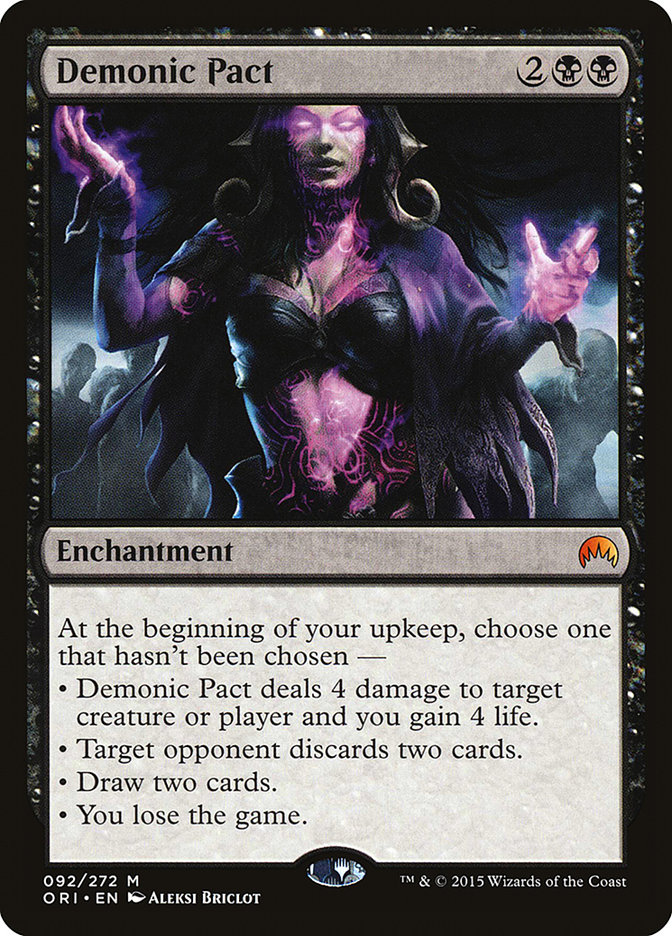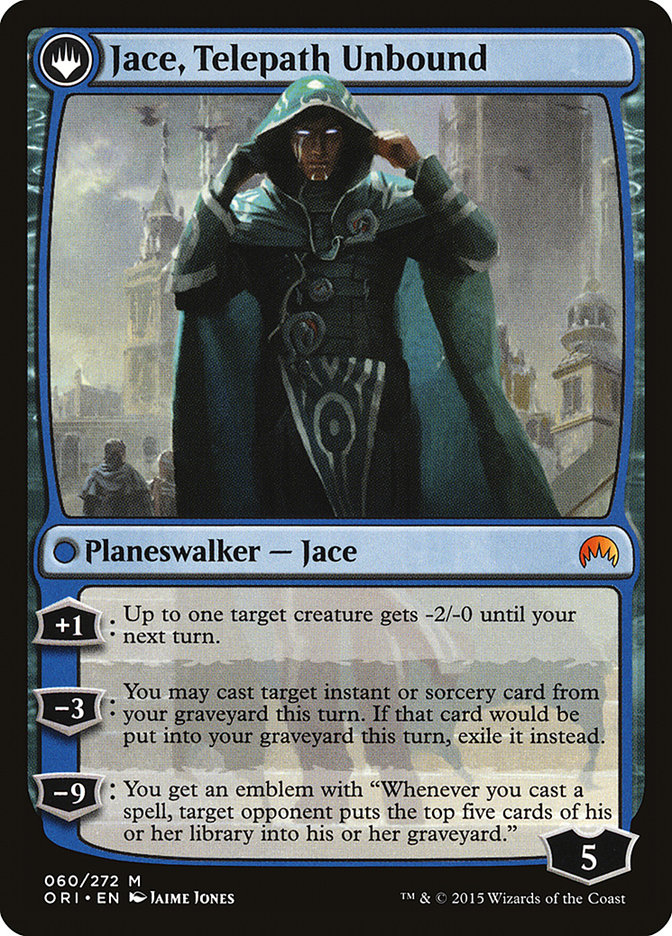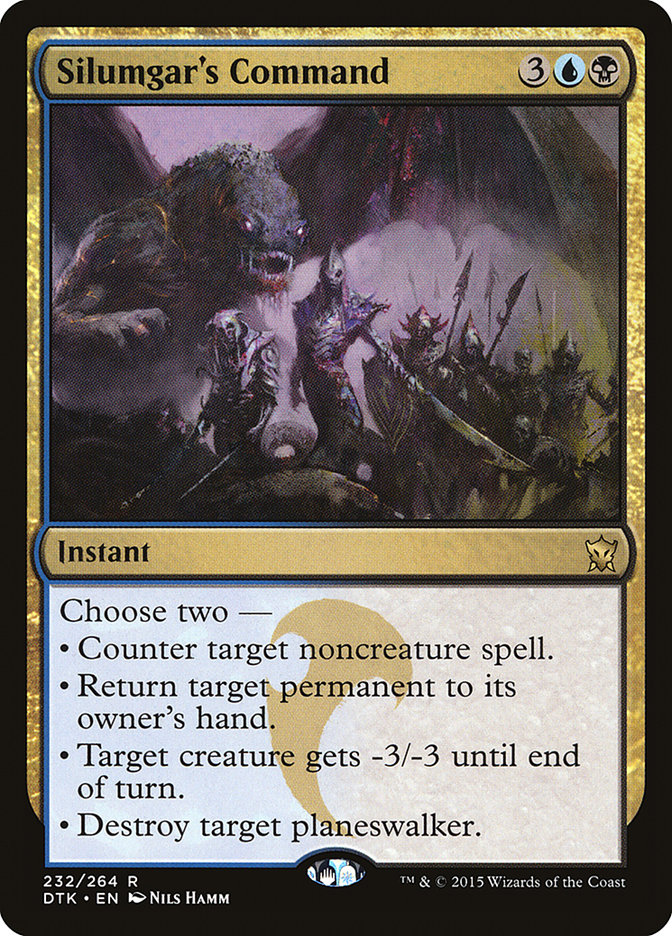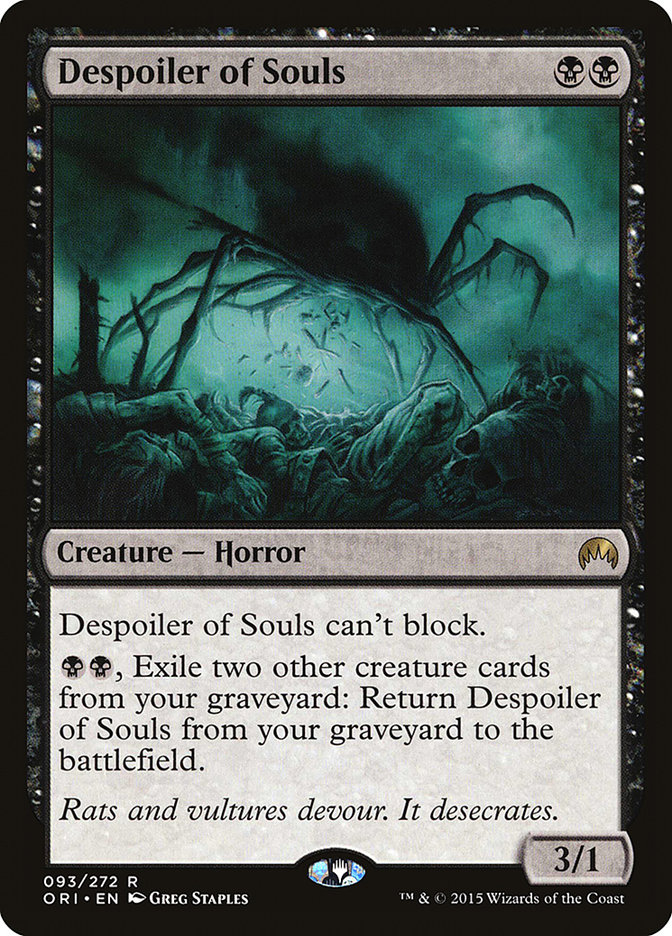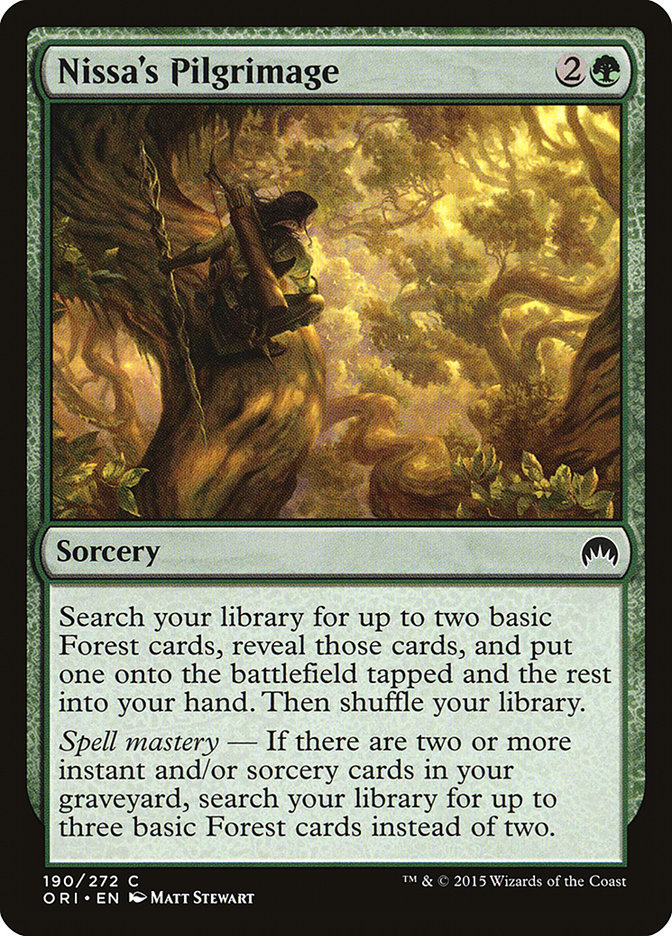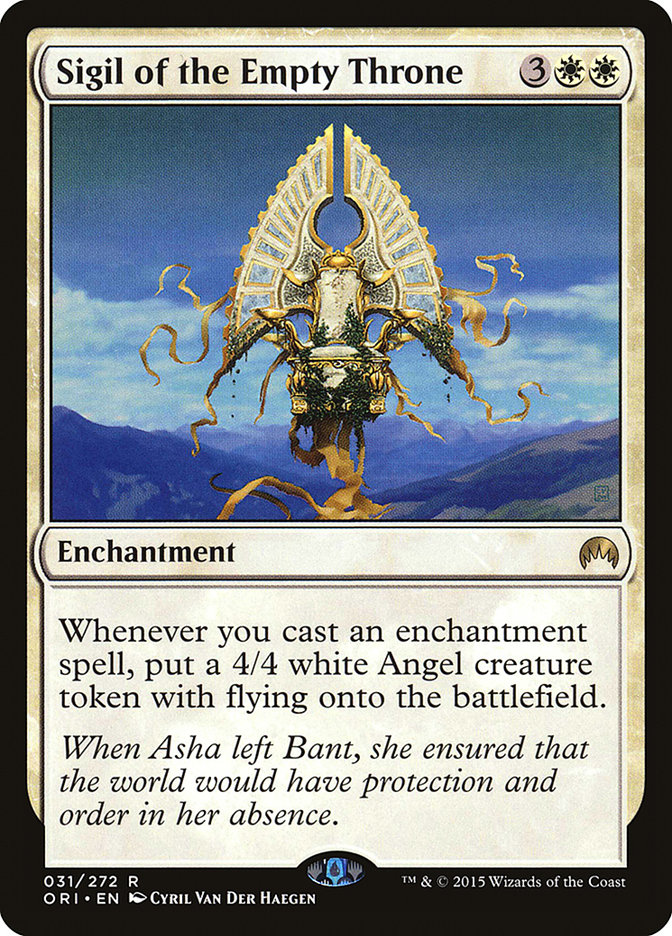This is probably the last week where I brew with Magic Origins before I have to go into lockdown mode for the Pro Tour. In the meantime, I shall brew!
There are two cards that I think might be the easiest ways to get ahead in Standard, especially in the first week. The first is clearly Demonic Pact. No one knows if this card is even playable, but I’m sure we’ll find out very quickly.
In order to use this card, you have to get rid of it before it kills you, but I don’t want to destroy it – I want to bounce it. Demonic Pact is going to put you way up on resources, and having to spend a card like Dromoka’s Command in order to destroy your own Demonic Pact is exactly what I don’t want to be doing. By bouncing the Demonic Pact, you get the opportunity to re-use it and hopefully find another bounce spell. If you’re focusing on destroying your own Demonic Pact, you’re giving up some of those valuable resources you just obtained.
We could try to use things like Perilous Vault and Ugin, the Spirit Dragon to blow up our Demonic Pact; that way at least you’re not really giving up any resources since you should want to be killing your opponent’s stuff anyway, but those are arguably worse than using Dromoka’s Command. Vault and Ugin are so slow that you might not get to activate them before the Demonic Pact forces you to lose. At least Dromoka’s Command is cheap and you can get a fight out of the deal.
For now, I’m looking at U/B.
Of course, the second card is Jace, Vryn’s Prodigy. It should be no surprise that these are my two favorites, as they both draw cards and both are actually kind of difficult to deal with. Right now, removal is mostly of the Hero’s Downfall variety, and if you want to spend three mana dealing with my two-mana spell, I’m very happy with that. Also, there are a lot of people out there who still seem to be undervaluing Jace, so they might not even target it at all! “I’ll wait for something better,” they might say. Well, “something better” may never come.
Other removal spells include Valorous Stance (ha!) and Dromoka’s Command. While Dromoka’s Command certainly does it since Jace apparently isn’t one to put up much of a fight, they might be able to make that happen if they’re on the play. Otherwise, at least you’re still getting a little value from your Jace and forcing them to skip their turn to remove it lest they risk falling too far behind.
Last week, I mentioned Demonic Pact as a card that I would wait for others to figure out. While Michael Majors set a ton of groundwork, I couldn’t wait any longer. I had to brew.
A quick Gatherer search turned up a card I overlooked, but is likely a game-changer.
Since we actually have a reason to play this card, I could easily see cutting Hero’s Downfall. Three-mana removal isn’t really what I wanted in the first place, especially since Bile Blight and Ultimate Price are getting more and more appealing, so being able to cut Hero’s Downfall makes me happy.
Obviously cutting a three-mana removal spell for a five-mana removal spell isn’t really an upgrade, but Silumgar’s Command is more than just a removal spell. For that five mana you will almost always get to remove two permanents from the battlefield, or perhaps counter something while killing something. You are definitely getting your five mana’s worth. It just so happens that one of the modes happens to help with resetting your Demonic Pact.
Here’s where I’m starting:
Creatures (6)
Lands (26)
Spells (28)

Jace, Vryn’s Prodigy and Demonic Pact work quite well together, and here’s why:
- If you have multiple Demonic Pacts that you don’t have time to cast, Jace can sift through them.
- If you have Void Snares that you don’t want to cast because you don’t have a Demonic Pact quite yet, Jace can sift through them.
- If you have Demonic Pact and need to get rid of it, the backside of Jace can “flashback” a way to make that happen.
- Together, they both provide you with a constant resource advantage over your opponent. Jace puts cards in the graveyard to fuel delve and can give your spells flashback. Demonic Pact goes to work on your opponent’s hand, which ends up being close to hard removal if you have an extra Void Snare lying around, plus it even draws you cards. Between the two, it should be relatively easy to grind your opponent into dust.
I like the first draft of the archetype, but there are two questions that need answering:
- How many ways to reset Demonic Pact do we need? I could easily see seven not being enough.
- Which are the correct ones? Each has their own pros and cons, and trying to build a deck around Demonic Pact while having each of those cards also be playable when you haven’t drawn a Demonic Pact may be tricky.
Another question that might be worth asking is “Is my deck just a worse version of Majors’s?”
Creatures (8)
Planeswalkers (3)
Lands (25)
Spells (24)

Some of the differences in his build are things I like, such as Sign in Blood, but other things, such as Gray Merchant of Asphodel, seem out of place. I do think the Silumgar’s Commands change this archetype drastically, but perhaps cutting Dissolve and going with Sign in Blood will yield better results. Perhaps a mash-up is in order.
I’ve got to get some games under my belt with Demonic Pact before I can speak on it any further, but there’s still plenty to say about Jace, Vryn’s Prodigy.
Creatures (18)
- 3 Goblin Rabblemaster
- 4 Mantis Rider
- 4 Soulfire Grand Master
- 4 Jace, Vryn's Prodigy
- 3 Harbinger of the Tides
Lands (25)
Spells (17)
- 3 Lightning Strike
- 2 Stoke the Flames
- 2 Dig Through Time
- 2 Valorous Stance
- 3 Wild Slash
- 3 Ojutai's Command
- 2 Clash of Wills
Sideboard

While I put together the pieces of Jace, Vryn’s Prodigy + Ojutai’s Command, I failed to notice the interaction between Harbinger of the Tides + Ojutai’s Command. Sometimes, I can be foolish. Some are looking at various blue devotion strategies with those cards, but Jeskai seems like a better fit. This is the tempo deck that wanted a Man-o’-War all along! All we have to do is cut down on the double-red requirements and shift the manabase to accommodate our new blue CMC 2 friends.
I think this brings up a larger point though. How exactly is Stormbreath Dragon supposed to compete against Harbinger of the Tides, especially in conjunction with Ojutai’s Command? I’d like to hope the answer is that Stormbreath Dragon is done for, but clearly Eric Rill’s lower-to-the-ground G/R Dragons deck doesn’t lean on Stormbreath Dragon. Still, Jeskai has a bunch of Wild Slashes if it wants them, so it’s not like we’ll be losing to Goblin Rabblemaster anytime soon.
Anyway, if Harbinger of the Tides is getting played across the board and not just in decks like U/X Devotion (which may or may not even be a deck), it does not bode well for Stormbreath Dragon and friends.
Clash of Wills is also solid here, assuming the metagame is not one in which you can maindeck Disdainful Stroke. You should pay attention though, because Clash of Wills isn’t exactly a freeroll. With ten lands that enter the battlefield tapped, you may find it difficult to Clash of Wills whatever you want, especially if you’re busy developing your board at the same time. Regardless, it’s definitely nice to be able to lock the game up with a counterspell, and Clash of Wills does that at a very low opportunity cost.
Overall, Jeskai appears to be one of the favorites leading into the Open Series in Chicago.
Two weeks ago, I presented a Mardu Aggro list that was my best-looking Liliana, Heretical Healer deck. Since then, we’ve been granted a gift that fits quite well in the archetype.
Creatures (22)
- 2 Tymaret, the Murder King
- 4 Goblin Rabblemaster
- 4 Butcher of the Horde
- 4 Bloodsoaked Champion
- 4 Liliana, Heretical Healer
- 4 Despoiler of Souls
Lands (24)
Spells (14)

Good luck keeping this deck down, as it has plenty of staying power.
Despoiler of Souls adds to that, giving us another creature that keeps coming back. Neither it nor Bloodsoaked Champion can block, but who wants to block in a Mardu deck?
Perhaps cutting Hordeling Outburst is a mistake as the absence of tokens makes our Butcher of the Horde significantly worse. However, Butcher of the Horde still transforms Liliana, Heretical Healer easily and there’s plenty of stuff you don’t mind sacrificing. The issue is that Bloodsoaked Champion and Despoiler of Souls have mana requirements to bring back. Then again, in order to power Butcher of the Horde with Hordeling Outburst, you need to pay some mana up front. We also still have Goblin Rabblemaster, so I think it’s OK.
The rest of the deck is exactly what I want to be doing. Thoughtseize is likely going to get better as mana curves tighten because it’s more likely that you can ignore their small stuff and take their most powerful card. Crackling Doom is also an all-star, and with what I assume will be a playset of Self-Inflicted Wounds in the sideboard, killing their creatures is going to be a lot of fun.
Perhaps the Murderous Cut is greedy, what with Despoiler of Souls being in the deck, but I wanted another removal spell. I think Ultimate Price is going to have very little downside moving into Magic Origins Standard, but you have to be careful during Week One since you never know what’s going to show up.
I could see going further down the Mana Confluence route, especially considering I wouldn’t mind a 25th land or a second Urborg, Tomb of Yawgmoth. Right now, nearly every land taps for black mana, which is kind of necessary when you’re trying to use Despoiler of Souls, but that can get kind of painful.
Creatures (19)
- 4 Elvish Mystic
- 4 Sylvan Caryatid
- 2 Genesis Hydra
- 3 Dragonlord Atarka
- 3 Dragonlord Dromoka
- 3 Nissa, Vastwood Seer
Planeswalkers (8)
Lands (25)
Spells (8)
Sideboard

I kind of glossed over this card, but after watching the VS Video with Todd Anderson and Tom Ross earlier this week, it’s clear that I made a mistake. This card does what Courser of Kruphix hopes to do every game. Courser of Kruphix also attacks, blocks, gains you life, and gives you a little bit of card selection, but ultimately what you’re hoping for is that it helps you make your land drops. Nissa’s Pilgrimage helps you do that and it even accelerates you. It can only get you Forests, but that shouldn’t be an issue with the Temples and fetchlands fixing your other colors.
Todd’s deck ignores Courser of Kruphix entirely, simply aiming to go over the top. Turn-four Ugin, the Spirit Dragon isn’t common, but it didn’t seem unrealistic either. Nissa herself might actually be a little too “small ball” for the deck, but with all the ramping it’s easy to transform her. She doesn’t have quite the impact on the game that Elspeth, Ugin, or even the dragonlords have though.
Improvements could likely be made. Todd seemed to use his mana every turn and he ran out of lands to fetch multiple times, so perhaps a manabase with fewer Temples is in order. That’s a good place to start, but I’d also want to know what this deck wants to be doing exactly. Do we need early answers to creatures or is going over the top of everyone good enough? In a format where people think Goblins might be one of the best decks, I’m a little wary of that plan.
I’ve got one final decklist.
This might be a game-changer.
Creatures (25)
- 4 Elvish Mystic
- 4 Sylvan Caryatid
- 4 Courser of Kruphix
- 4 Eidolon of Blossoms
- 4 Doomwake Giant
- 1 Pharika, God of Affliction
- 4 Herald of the Pantheon
Lands (24)
Spells (11)

This might not be the correct way to build the deck, but I do think it involves the core of:
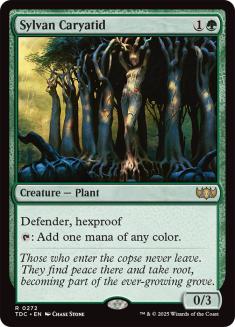
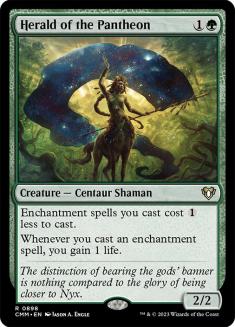
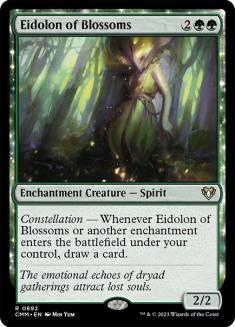
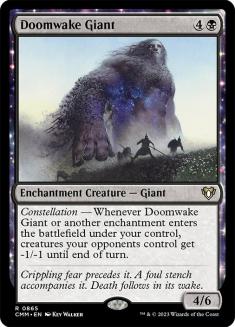
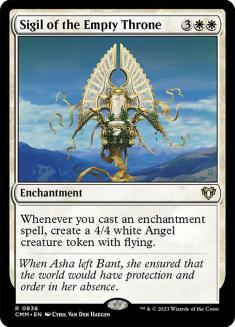
The light black splash made sense to me, especially since white has some excellent removal options. I would expect to get blown out by Back to Nature at any point, so there’s no reason to try and mitigate something that will be a game-ending disaster either way.
A while back, Brad Nelson had a Constellation deck that also contained Chained to the Rocks, and that might be a good place to be also. You need a Mountain in play, but your removal ends up being much cheaper as a result. Then again, Herald of the Pantheon turns your Suspension Fields into situational Chained to the Rocks, so maybe it’s not a big deal at all.
I’m willing to try this deck, but I’m really not expecting it to do anything more powerful than the other midrange decks. Dragonlord Atarka destroys you and so does Ugin, the Spirit Dragon, but maybe Sigil of the Empty Throne does enough work that it’s worth it.
What has everyone else been working on? What’s shown promise so far in your Origins testing? Is there a sleeper I’ve missed completely? Share below!

